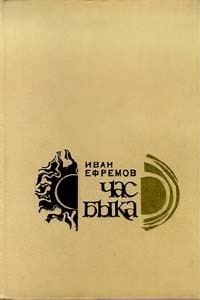Original title Час Быка Series The Great Circle Originally published 1970 | ||
 | ||
Illustrator Galina Boyko and Igor Shalito Similar Ivan Efremov books, Science Fiction books | ||
The Bull's Hour ( Russian: Час Быка, Chas Byká) is a social science fiction novel written by Soviet author and paleontologist Ivan Yefremov in 1968. Six months after its publication Soviet authorities banned the book and attempted to remove it from libraries and bookshops after realizing that it contained a sharp criticism of the current state of affairs in the USSR disguised as a critique of "Capitalism" and Chinese-style communism of that time.
Contents
- Plot summary
- Main concepts
- The Eras of human history
- Starship Dark Flame crew
- Planet Tormance characters
- References
This novel is considered a sequel to the 1957 novel Andromeda: A Space-Age Tale, taking place in the same universe some century or more later. Even though the cast of characters is entirely different, an occasional reference is made to the events and characters of the previous volume. For example, the main character in The Bull's Hour is a female historian who on one occasion remembers most of the notable Andromeda characters as historical figures.
Not one state has such a right [to deny access to information], not one planet! The sacred duty of each of us is to contravene such an unprecedented oppression. Who dares block the way of a sentient reasoning being towards knowledge? ... When in the Great Circle a state is discovered that blocks the way to knowledge for its people, such a state is dismantled. This is the only case that gives the right to interfere in the affairs of another planet. ... the prohibition to learn about arts, sciences, life on other planets, is unacceptable.
Plot summary
Some 3000 years in the future, a Communist Earth has just developed faster-than-light space travel based on the experiment of Ren Boz (of The Andromeda Nebula). Using the new technology, Earth constructs "straight-beam" starships which travel by sliding on the edge between our Universe ("Shakti") and the Anti-Universe ("Tamas"). The second ship of that kind, Dark Flame, departs from the Solar System on a mission to a habitable planet Tormance (the name is borrowed from David Lindsay's A Voyage to Arcturus) in the Lynx constellation, which was reported by alien space voyagers from Cepheus to be colonized by humans, thought to be Earth escapees from the Age before World Unification.
The society of this distant planet is labelled by Efremov as "an amalgamation of a Capitalism in its worst form and of a Chinese pseudo-socialism" and a part of "Inferno" (a deep philosophical concept of Efremov's relating to the Nature and the natural way of things, always as he claims infernal towards the living thinking sentient beings), a society in which ordinary workers' lives are limited to 26 local years ("short-living", KJI, or КЖИ for Russian: "КороткоЖИвущие") while scientists, engineers and other selected qualified professionals live out their natural lives ("long-living", DJI, or ДЖИ for Russian: "ДолгоЖИвущие"), with artists, sportspeople and "models" given somewhat longer life-spans than that of KJI (up to about 34 years). Both KJI and DJI are under the ruthless totalitarian control of the ruling class of government bureaucracy ("snake-carriers", similar to the prototypical "inner-party members" of Orwell's 1984) and the police forces ("the lilac"), which in turn are under the direct command of the Council of Four and its Chairman, the actual Ruler of the planet. The most shocking aspect of its civilization for the Earthians is its total control of information, maintaining separate information systems for separate social strata, with full and true information available ultimately only to the Supreme Leader (who, for example, is the only one on the whole planet knowing that Tormance people are, in fact, from Earth).
The plot follows the Communist crew as they establish contact and explore the planet's society, eventually sacrificing some lives including that of the expedition leader, female historian Fay Rodis, for the sake of free future of the planet and its people's children. Their influence is predominantly through providing full and true information freely to all people about Earth's past and present, and their views of the situation on the planet. They also provide a selective short memory-eraser (a modifier of social and behavioural skills) to be used against the system's spies by the nascent resistance. Also, some of the crew (esp. Rodis) have the mental capacity to do the same sort of influence without use of the device. Every member of the crew was also accompanied by a nine-legged discoid robot called SDF (Servant, Defender and Freighter).
Main concepts
Not one state has such a right [to deny access to information], not one planet! The sacred duty of each of us is to contravene such an unprecedented oppression. Who dares block the way of a sentient reasoning being towards knowledge? ... When in the Great Circle a state is discovered that blocks the way to knowledge for its people, such a state is dismantled. This is the only case that gives the right to interfere in the affairs of another planet. ... the prohibition to learn about arts, sciences, life on other planets, is unacceptable.
The Eras of human history
Spanning approximately three thousand years from the 20th century to the present time of the novel, these are:
It is hinted that a devastating world war has occurred between the eras of Disjoint World and World Reunion, nearly wiping out the Humanity. And prior to it there was a period of great ecological degradation and pollution resulting in widespread diseases, genetic and otherwise, increase in cancer rates and planet-wide epidemics (that's when the progenitors of Tormancian human population had left the "doomed" Earth on a starship flotilla that subsequently "fell through a space-time anomaly", and found itself near the inhabitable planet of Tormance, by pure chance).
